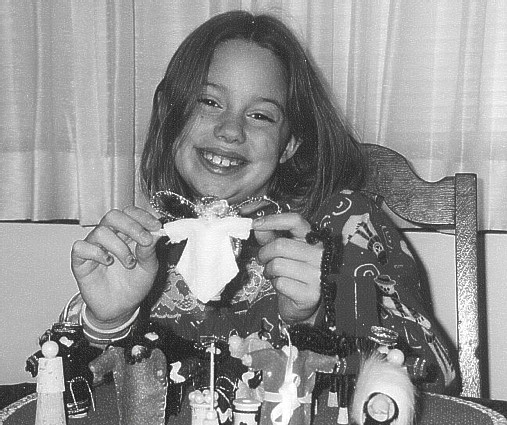
Katherine and her angel
Comments? [email protected].
Other columns from 2001 may be found at: 2001 Index.
Links to previous years are on the home page: Home
Kansas Snapshots by Gloria Freeland - December 6, 2001
Nativity collection
The construction-paper and pine cone turkeys are put away until next Thanksgiving.
The girls and I started getting out our Christmas decorations on Sunday. We usually do a little bit each weekend rather than hauling all the boxes out at once. We now have Christmas books, a Christmas village and train, and nativities on display.
I collect nativities, but I don't have as many as my friend Judy in Texas, who has nearly 1,700 nativities and whose husband, Monroe, built her a special "Bethlehem" building just for displaying them.
But I do have quite a number of them myself - enough to cover the top of my dining room hutch and two or three small tables in the living room. The nativities hail from Kansas, Germany, Bolivia, Ecuador, Mexico and other places.
When my oldest daughter was around 2, my mother made a stable out of a box covered with brown contact paper that looked like wood. The stable includes a small bulb, representing the star, a button that starts a music box that plays "Silent Night," and plaster figures of the Holy Family, wise men, shepherds and animals. That nativity is large enough and is played with enough that it usually sits on the floor. Nativities that my daughters drew when they were 7 or 8 are displayed in frames on the hutch each year.
Other nativities are made from a variety of materials: plastic, wood, straw, cloth, pewter, clay, yarn, goose eggs, wooden eggs and paper. The plastic one, about two inches wide by about one inch high, is stamped "Made in Portugal." My uncle and aunt from California gave it to me when I was about 6 or 7, and I still remember my excitement when I opened it on Christmas Eve.
The wood ones include a delicately carved nativity from Oberammergau, Germany, which is known for the Passion Play presented there every 10 years; a roughly carved one from Cochabamba, Bolivia; and a smooth one from Marlow Woodcuts in Americus, Kan.
Another nativity from Bolivia is made of burlap cloth. The figures are hand-stitched and embroidered, and include a lion, a llama and a condor, the national bird of Bolivia.
A wheat straw nativity was made by a woman from my hometown of Burns, Kan. and a small basket with straw figures of Mary, Joseph, baby Jesus and a cow on the lid came from Ecuador, where I was a Peace Corps volunteer.
The tiniest nativity of my collection is a set of nine hand-painted figures, the largest of which is maybe one-half inch tall. I bought the set in Nuremberg, Germany last spring. The nine figures fit into a matchbox with the following imposing German words imprinted on the front of the box: "Puppenstubenzinnfiguren Weihnachtskrippe," which, loosely translated, mean: "Doll house pewter figures for a Christmas crib."
My daughter Katherine and I are making the latest nativity for our collection - assuming that we get it done. The figures are made of chenille pipe cleaners, corks, felt and ribbons. We saw the idea in a recent Better Homes and Gardens magazine, and thought it looked like fun. If we finish one figure a night, we SHOULD be done with baby Jesus, Mary, Joseph, two shepherds, three wise men, an angel, a donkey, three camels, two cows and two sheep by the time Christmas comes!
I thought it might be interesting to take the girls to "Bethlehem Revisited," a re-enactment of the first nativity, on the Judson and Nancy Swihart farm near Keats. It was coordinated by the Grace Baptist Church and included about 70 actors. I had been to "Bethlehem" several years ago, but the one on Sunday evening was an expanded version.
The actors - prophets, Roman soldiers, Mary, Joseph, shepherds, wise men and others - interacted with those of us on the "tour." Various animals supported the actors in their roles: Roman soldiers rode horses; a pregnant Mary rode a small donkey with Joseph guiding it; shepherds tended their flocks on the hills; chickens in Bethlehem's marketplace created a ruckus in their cages; and calves in the stable munched on straw while the baby Jesus slept in his mother's arms nearby.
The setting in the wooded, rocky, hilly area made us feel as though we were traveling back in time. It was a great way to get us in the mood for Christmas - and to inspire us to finish our latest nativity project.

Katherine and her angel
Comments? [email protected].
Other columns from 2001 may be found at: 2001 Index.
Links to previous years are on the home page: Home